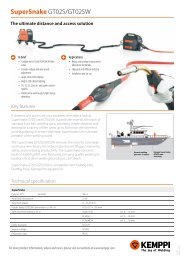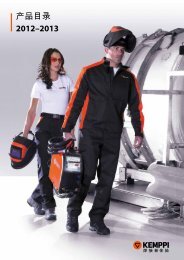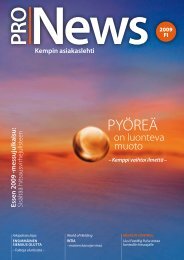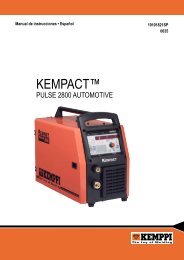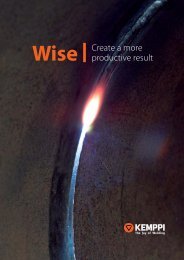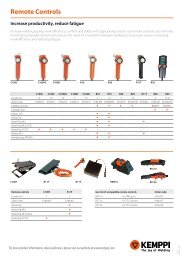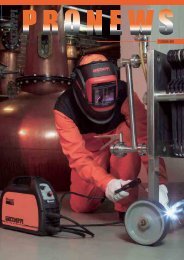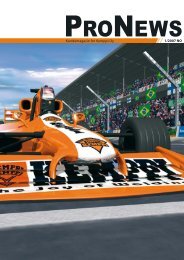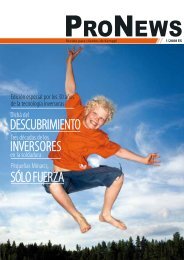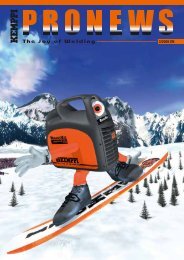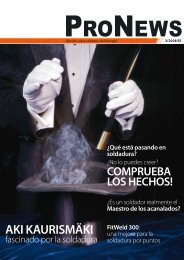Create successful ePaper yourself
Turn your PDF publications into a flip-book with our unique Google optimized e-Paper software.
18<br />
<strong>Kemppi</strong> ProNews 2 • 2006<br />
”In this course the participants are people who<br />
sail the seas, where something can always break and<br />
need immediate repair. This is not the time or place to<br />
go over all the fi ne points of metallurgy, but rather to<br />
present methods which can be used to deal with unexpected<br />
repair situations.<br />
Professor Martikainen explains that the welding industry<br />
has recently made small, but signifi cant advances. There<br />
are no single revolutionary innovations to speak of, but<br />
today’s most important trend on the welding equipment<br />
market has more to do with the integration of various<br />
sectors to form a single, competitive package.<br />
Participants learn new tricks from their<br />
colleagues during the course<br />
Even though a welder is more likely to be a practical,<br />
hands-on type than someone who enjoys attending lectures<br />
and discussing theory, the <strong>Kemppi</strong> course was<br />
praised also for the practical orientation of its theoretical<br />
aspects.<br />
The greatest praise, however, was reserved for the welding<br />
exercises as well as the discussions with <strong>Kemppi</strong><br />
welding experts and other welders working in the industry.<br />
The sharing of thoughts and ideas among colleagues<br />
was considered a very welcome way to develop one’s<br />
own skills and get practical new tips to help in working.<br />
”The best thing about this course was that we got advice<br />
from professionals,” says course participant, Harry<br />
Korhonen. ”When you usually just talk to do-it-yourself<br />
guys, this level of industry expertise naturally makes<br />
quite an impression.”<br />
Ari Niiniketo also praised the course arrangements. This<br />
was the fi rst time he attended a course like this, where<br />
theory meets practice in such a productive way.<br />
Kohonen and Niiniketo, on a coffee break<br />
from the course, feel that the need for the<br />
course is also important simply for the<br />
fact that today’s welding equipment is<br />
so complex that being able to make<br />
use of every fi nesse and feature requires<br />
a great deal of know-how.<br />
The course ended on Friday afternoon<br />
with TIG and electrode welding exercises,<br />
which was followed by a closing<br />
discussion forum. n<br />
Welding Technology<br />
Professor Jukka<br />
Martikainen is an<br />
experienced lecturer.<br />
At the <strong>Kemppi</strong><br />
course his lectures<br />
were more practical<br />
in nature than his<br />
lectures at university.<br />
Tighter<br />
MIG brazing<br />
requirements<br />
High-strength steel standard for the<br />
automotive industry<br />
Reducing vehicle weight is a key objective of the automotive<br />
industry. Even though the effi ciency of engines<br />
has improved, manufacturers have had to increase power<br />
output in order to ensure performance, as the increase<br />
in safety equipment has increased vehicle weight. Due<br />
to today’s high fuel prices, manufacturers are looking<br />
for areas where weight can be saved. A slight savings in<br />
weight is provided by high-strength steel, which when<br />
used can result in as much as 30% lighter solutions than<br />
normal steel, without compromising on body strength<br />
ZST340 high-strength steel is used a great deal in the<br />
European automotive industry. An even stronger alternative<br />
is boron steel, whose yield strength can be even<br />
more than 1200 N/mm 2 . Boron steel is used in body<br />
window frames, B pillars, crossbeams and roof roll bars<br />
(safety arch). Boron steel is used in such models and<br />
makes as the BMW E60, Saab, Volvo XC90, Porsche<br />
Cayenne and VW Touareg.<br />
Stronger fi ller materials<br />
Copper-based MIG brazing wire, which was introduced<br />
with zinc-coated panels, has developed in pace with<br />
various types of steel. Due to its lower melting point,<br />
there is less vaporisation of zinc from the brazing joint<br />
as well as less heat generated. Indeed, there have been<br />
no great changes in the melting points of fi ller materials<br />
because the quantities of primary alloy materials have<br />
mostly remained the same. The old norm SG-CuSi3<br />
DIN 1733 has been replaced by EN 14640 S CU 6560.<br />
Previously, steel strengths were much greater than the<br />
MIG brazing fi ller materials used. Today, there are fi ller<br />
materials, such as bedra® CuSi3Mn wires, whose tensile<br />
strength can exceed 1000 N/mm 2 . Such strength sounds<br />
unbelievable, but it gives the engineer the possibility of<br />
designing even stronger and, more importantly, safer<br />
structures. <strong>Kemppi</strong> has tested these strong fi ller materials<br />
with the <strong>Kemppi</strong> Pro Automotive and Kempact



